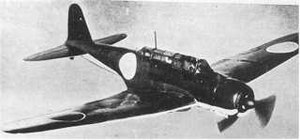Nakajima B5N
| B5N | |
|---|---|
 |
|
| Nakajima B5N2 "Kate" in flight. | |
| Role | Torpedo and dive bomber |
| National origin | Japan |
| Manufacturer | Nakajima Aircraft Company |
| First flight | 1937 |
| Retired | 1945 |
| Status | Retired |
| Primary user | Imperial Japanese Navy |
| Number built | 1,149 |
The Nakajima B5N (Japanese: 中島 B5N, Allied reporting name "Kate") was the standard carrier torpedo bomber of the Imperial Japanese Navy (IJN) for much of World War II.
Although the B5N was substantially faster and more capable than its Allied counterparts, the TBD Devastator, Fairey Swordfish and Fairey Albacore, it was nearing obsolescence by 1941. Nevertheless, the B5N operated throughout the whole war, due to the delayed development of its successor, the B6N. In the early part of the Pacific War, flown by well-trained IJN aircrews and as part of well-coordinated attacks, the B5N achieved particular successes at the battles of Pearl Harbor, Coral Sea, Midway, and Santa Cruz Islands.
Primarily a carrier-based aircraft, it was also occasionally used as a land-based bomber. The B5N carried a crew of three: pilot, navigator/bombardier/observer, and radio operator/gunner.
The B5N was designed by a team led by Katsuji Nakamura in response to a 1935 specification by the Navy for a torpedo bomber to replace the Yokosuka B4Y. Internally designated Type K by Nakajima, it successfully competed with the Mitsubishi B5M for a production contract. The first prototype flew in January 1937 and was ordered into production soon afterwards with the full designation Type 97 Carrier Attack Bomber (kyū-nana-shiki kanjō kōgeki-ki or kankō for short 九七式艦上攻撃機).
...
Wikipedia
